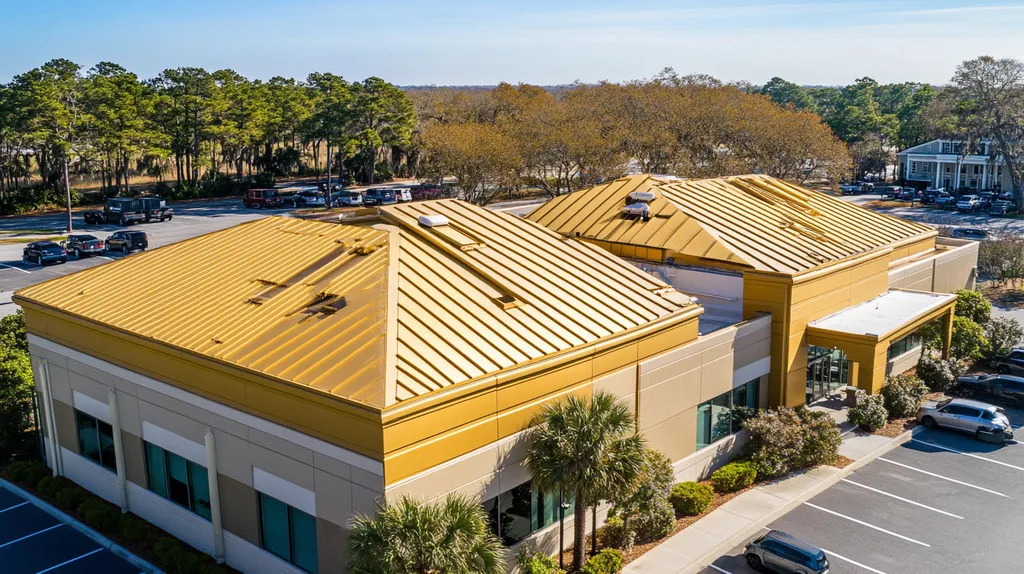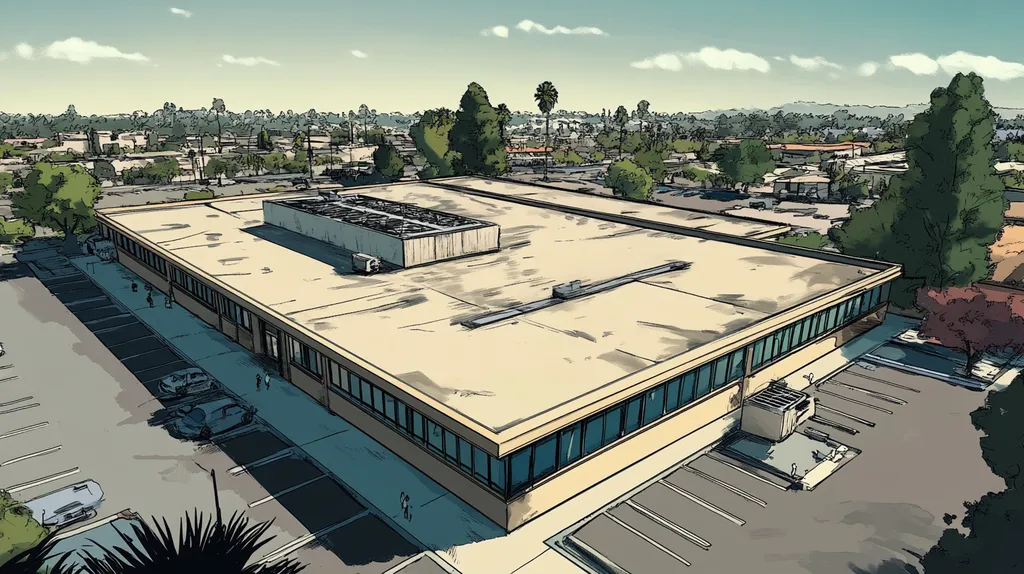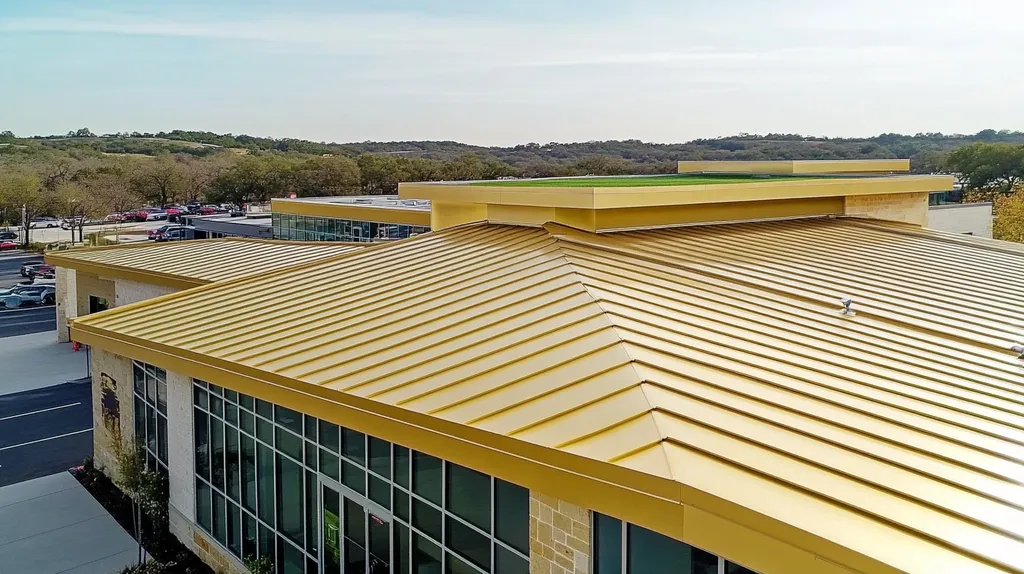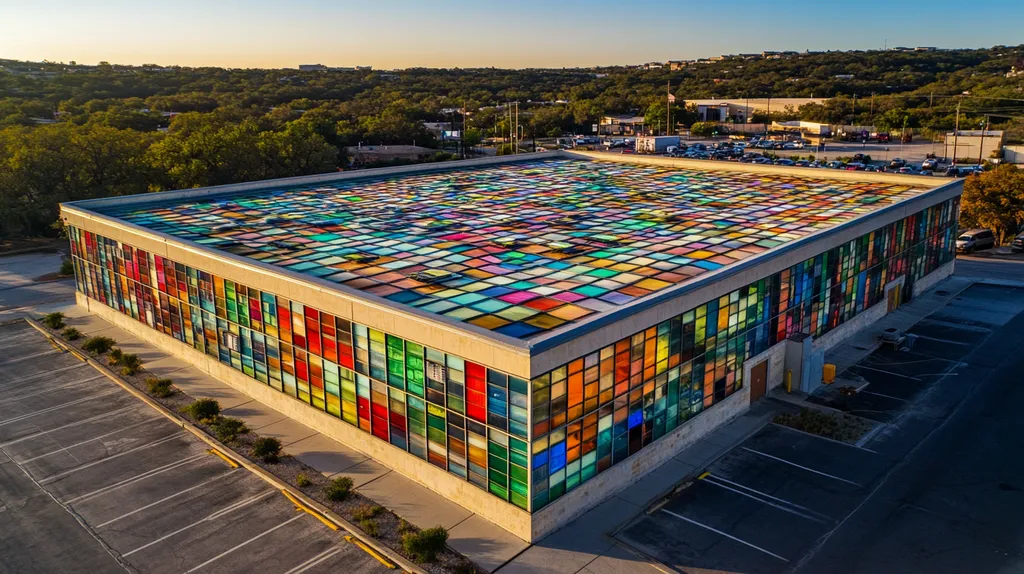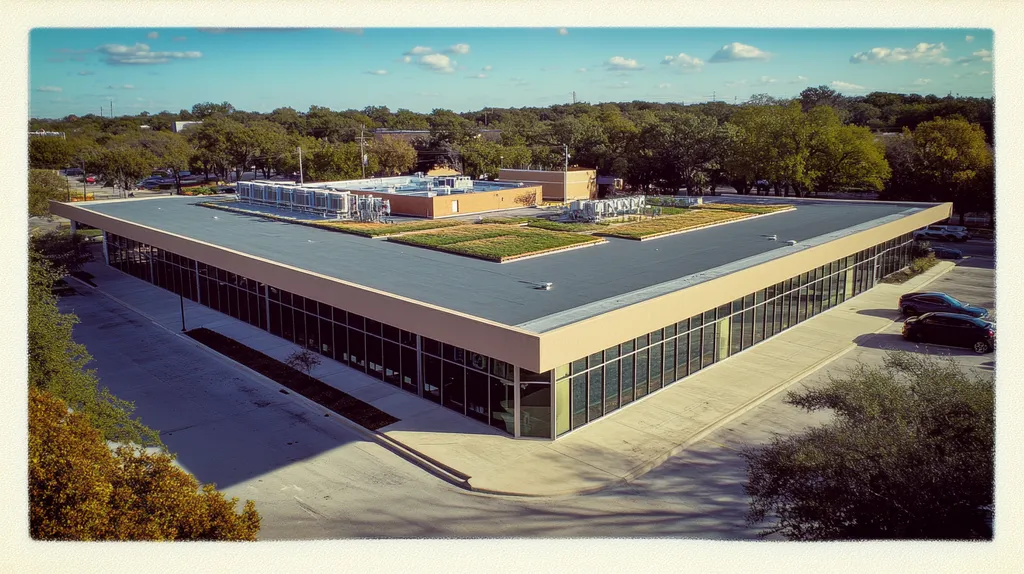Every hour of manufacturing downtime costs industrial facilities an average of $260,000 in lost production. When roof maintenance becomes necessary, traditional repairs often force complete operational shutdowns.
Modern roof coating solutions offer a way to protect and maintain industrial roofs while keeping disruptions to an absolute minimum. Understanding these innovative approaches helps facility managers balance critical building maintenance with operational continuity.
This guide examines how industrial facilities can leverage roof coating technologies to maintain productivity, extend roof life, and prevent costly shutdowns during essential roofing work.
SECTION 1: THE BASICS EXPLAINED
Every hour of production downtime in industrial facilities can cost thousands in lost revenue. When roof maintenance becomes necessary, traditional repairs often force operations to halt completely. Modern roof coating solutions offer a way to protect and maintain industrial roofs while keeping disruptions minimal. Understanding these solutions helps facility managers make informed decisions that balance building maintenance with operational continuity.
What It Is (In Plain Language)
Roof coatings are specialized liquid materials that create a seamless, protective layer over existing industrial roofs. These coatings form a waterproof membrane that shields the underlying structure from water, UV rays, and temperature fluctuations.
Unlike traditional tear-off and replacement methods, coatings can be applied directly to most existing roof surfaces. Common types include acrylic, silicone, and polyurethane formulations, each engineered for specific roofing materials and environmental conditions.
The coating system creates a continuous barrier without seams or joints where leaks typically develop. This seamless protection extends across the entire roof surface, including flashings, penetrations, and other vulnerable areas.
Because the application process is typically quick and non-invasive, warehouses can continue operations with minimal interruption. (source: Topps Products Blog)
Why It Matters (To Your Building)
A properly coated roof directly impacts facility operations and maintenance costs. The reflective surface reduces heat absorption, leading to lower cooling expenses and more stable interior temperatures.
The waterproof membrane prevents moisture infiltration that could damage inventory, equipment, and interior finishes. This protection is especially crucial in facilities with sensitive electronics or materials that must stay dry.
Regular coating maintenance extends roof life by 10-15 years, postponing expensive replacement projects. This lifecycle extension allows facilities to better plan capital expenditures and maintenance schedules.
The non-disruptive nature of coating applications means facilities can maintain productivity during roof maintenance. This advantage becomes particularly valuable in 24/7 operations where shutdown costs are substantial.
How It Works
The coating process begins with thorough surface preparation. Crews clean the existing roof, repair any damage, and ensure proper drainage – all while normal operations continue below.
Application methods vary by coating type and roof configuration. Spray equipment provides fast coverage for large areas, while rollers and brushes handle detail work around equipment and penetrations.
Most coatings cure within 24-48 hours, though some areas may require restricted access during this time. Strategic scheduling of work sections allows facilities to maintain access to critical roof-mounted equipment.
The completed coating system requires minimal maintenance beyond periodic inspections. Touch-ups or recoating can be performed as needed, following the same low-impact process as the initial application.
SECTION 2: PRACTICAL APPLICATIONS
Industrial roofing decisions directly impact operational continuity and bottom-line results. Every unplanned shutdown due to roof issues can cost facilities tens of thousands in lost productivity. Modern coating solutions offer strategic advantages for maintaining industrial roofs while keeping operations running. Understanding their practical applications helps facility managers implement effective roofing strategies that protect both assets and productivity.
Common Uses & Examples
Industrial facilities primarily use roof coatings to extend service life and prevent water infiltration. These solutions create seamless protection across large roof areas, effectively sealing around penetrations and equipment mounts that often become vulnerable points.
Manufacturing facilities frequently apply reflective coatings to reduce heat absorption and lower cooling costs. This approach is particularly effective in metal buildings where temperature control directly affects production efficiency.
Food processing plants and pharmaceutical facilities choose chemical-resistant coatings that withstand aggressive cleaning protocols. These specialized formulations maintain their protective properties even under frequent exposure to sanitizing agents.
Distribution centers utilize coating systems to maintain watertight conditions protecting inventory and equipment. The continuous membrane eliminates seams where water could potentially enter, reducing the risk of costly product damage.
When You Need It Most
Roof coatings become essential when aging roofs show early signs of deterioration but aren’t yet requiring complete replacement. This preventive approach costs significantly less than emergency repairs or premature roof replacement.
Facilities experiencing rising energy costs often turn to reflective coatings as an immediate solution. The enhanced thermal performance can reduce cooling demands within weeks of application.
Before major equipment installations or renovations, coating applications protect the roof from construction traffic and new penetrations. This timing minimizes the risk of damage during facility upgrades.
Seasonal transitions, particularly before periods of heavy rainfall or extreme temperatures, present ideal timing for coating applications. This scheduling helps ensure maximum protection when environmental stresses are highest.
Interactions With Other Systems
Roof coatings significantly impact HVAC performance by reducing heat transfer through the roof assembly. Proper coating selection can enhance the efficiency of rooftop units and reduce their workload.
Building automation systems often incorporate roof coating performance into their monitoring protocols. Temperature sensors can track the effectiveness of reflective coatings and identify areas needing maintenance.
Lightning protection and electrical systems require special consideration during coating applications. Installers must maintain proper grounding while ensuring complete coverage around these critical components.
Drainage systems benefit from coating applications that maintain positive flow to outlets. The seamless nature of coating systems eliminates places where water can pond, reducing stress on drainage components and underlying structures.
SECTION 3: KEY TERMINOLOGY DECODED
In industrial roofing, misunderstanding technical terms can lead to costly project delays and system failures. A single misinterpreted specification can result in using incompatible materials or incorrect application methods, potentially forcing production shutdowns for repairs. Clear communication between facility managers, contractors, and manufacturers becomes essential for maintaining operational continuity during roof coating projects.
Essential Terms Explained
Roof coatings are specialized liquid-applied materials that create seamless, waterproof membranes over existing industrial roofs. These protective layers shield against UV rays, moisture infiltration, and temperature fluctuations while allowing facilities to maintain normal operations during application.
The substrate refers to the existing roof surface receiving the coating. Understanding substrate composition and condition is crucial since it determines coating compatibility, surface preparation requirements, and application methods.
Dry film thickness (DFT) indicates the final thickness of the cured coating layer. Proper DFT ensures optimal performance and durability, directly impacting how long facilities can operate without requiring additional maintenance.
Cure time represents the period needed for coatings to achieve full strength and adhesion. Strategic scheduling of cure times around facility operations prevents disruption to critical processes and roof-mounted equipment access.
Industry Jargon Translated
Adhesion testing measures how strongly coatings bond to the substrate. Poor adhesion can lead to coating failure and unexpected production interruptions for emergency repairs.
Surface profile describes the microscopic roughness of the substrate. Correct profiling ensures proper coating adhesion and prevents premature failure that could impact facility operations.
Ponding water refers to moisture that remains standing on roofs for more than 48 hours. Understanding ponding helps facility managers address drainage issues that could compromise coating performance and lead to leaks.
Recoat window indicates the timeframe when additional coating layers can be applied without special surface preparation. Missing this window requires additional prep work that could extend project timelines and facility disruption.
Measurement & Units Simplified
Coating coverage rates are typically expressed in square feet per gallon. Accurate coverage calculations prevent material shortages that could force work stoppages and extend project duration.
Solar reflectivity measures the percentage of sunlight reflected by coatings, typically ranging from 0 to 100%. Higher reflectivity reduces cooling costs and improves working conditions in unconditioned spaces.
Elongation percentage indicates how much a coating can stretch without breaking. This matters for buildings that experience thermal movement or structural settling, as inadequate elongation leads to coating failure.
Tensile strength measures coating resistance to tearing and is expressed in pounds per square inch (psi). Higher tensile strength provides better durability against roof traffic and mechanical equipment maintenance.
SECTION 4: DECISION FACTORS
When industrial facilities need roof maintenance, every decision carries significant financial implications. A single misstep in coating selection can lead to premature failure, forcing unplanned production shutdowns that cost thousands per hour. Understanding the key factors that drive successful coating projects helps facility managers protect both their buildings and operational continuity.
Cost Considerations
Roof coatings offer a faster, more cost-effective solution compared to traditional tear-off and replacement methods. The ability to apply coatings directly over existing roofs eliminates waste and demolition expenses while maintaining operations. (source: BlueTeam)
Initial material costs vary significantly between coating types. Premium formulations typically command higher upfront prices but often deliver better long-term value through extended service life and reduced maintenance needs.
Labor costs depend heavily on roof accessibility and condition. Complex configurations with numerous penetrations or extensive surface preparation requirements increase installation expenses.
Energy savings from reflective coatings should factor into cost calculations. Reduced cooling loads can offset initial investments through lower utility bills and extended HVAC equipment life.
Performance Trade-offs
Different coating formulations excel in specific performance areas while potentially sacrificing others. Understanding these trade-offs ensures selections align with facility priorities.
Chemical resistance often comes at the expense of UV stability. Facilities must balance protection against specific exposures with overall weathering performance.
Flexibility and hardness represent another key trade-off. Highly flexible coatings accommodate building movement but may show reduced puncture resistance.
Application temperature ranges affect project scheduling. Some coatings offer wider application windows but may compromise on other performance attributes.
Lifespan & Durability Factors
Expected service life varies dramatically between coating types and exposure conditions. Premium systems may last 20+ years while basic coatings might require reapplication within 5-10 years.
Substrate condition significantly impacts coating longevity. Proper surface preparation and primer selection become critical when dealing with aged or deteriorated roofing.
Maintenance requirements affect long-term durability. Some coatings need regular recoating to maintain optimal performance, while others offer extended service with minimal upkeep.
Environmental stresses like UV exposure, chemical fallout, and mechanical abuse accelerate coating degradation. Local conditions must guide material selection to achieve maximum service life.
SECTION 5: COMMON CHALLENGES
Industrial roof coating projects face critical challenges that can severely impact facility operations. A single coating failure can result in production losses exceeding $100,000 per day in large manufacturing facilities. Weather delays, improper application, and inadequate surface preparation represent the most common issues that threaten operational continuity. Understanding and addressing these challenges proactively helps facility managers maintain production schedules while ensuring proper roof protection.
Frequent Problems & Solutions
Surface contamination represents the leading cause of coating failures in industrial settings. Oil, grease, and industrial residues prevent proper adhesion, leading to premature coating breakdown and potential water infiltration.
Because the application process is typically quick and non-invasive, warehouses can continue operations with minimal interruption when proper preparation protocols are followed. Strategic scheduling and sectional applications allow facilities to maintain critical access while ensuring thorough coverage. (source: Topps Products Blog)
Temperature and humidity fluctuations during application can compromise coating performance. Installing temperature monitoring systems and scheduling work during optimal weather windows helps ensure proper curing.
Inadequate coverage around roof penetrations and flashings creates vulnerable points. Detailed inspection protocols and specialized application techniques for these areas prevent localized failures.
Warning Signs To Watch For
Surface blistering and delamination indicate moisture trapped between the coating and substrate. Regular infrared scanning can detect moisture issues before visible damage appears.
Crazing and cracking patterns suggest coating stress from building movement or thermal cycling. Monitoring these patterns helps identify areas requiring additional flexibility or reinforcement.
Premature erosion or thickness loss points to inappropriate coating selection or application. Periodic membrane thickness testing identifies wear patterns requiring attention.
Changes in interior temperature stability often signal coating degradation. Tracking energy consumption patterns helps detect performance decline before water infiltration occurs.
Preventative Approaches
Implementing comprehensive moisture mapping before coating application prevents trapped water issues. This process identifies wet insulation and substrate areas requiring remediation.
Establishing clear communication protocols between coating crews and facility operations prevents workflow conflicts. Coordinated scheduling ensures critical production areas remain accessible during application.
Creating detailed maintenance documentation helps facilities track coating performance over time. This data enables predictive maintenance planning that minimizes operational impacts.
Training facility staff in basic coating inspection techniques provides early problem detection. Regular visual assessments can identify developing issues before they require extensive repairs.
SECTION 6: NEXT STEPS & RESOURCES
Choosing the wrong industrial roof coating strategy can cost facilities millions in operational disruptions and premature system failures. Every day of delayed or improper coating work risks production losses, inventory damage, and employee safety. Making informed decisions about coating providers, understanding compliance requirements, and staying current with industry developments helps facility managers protect both their buildings and bottom lines.
Questions To Ask Providers
Start by examining the provider’s specific experience with industrial coating applications. Request detailed explanations of their strategies for maintaining facility operations during installation, including their approach to scheduling around production peaks.
Verify their knowledge of your industry’s unique requirements. Food processing facilities, for instance, need contractors familiar with FDA compliance, while manufacturing plants require expertise in handling chemical exposures.
Request documentation of their quality control procedures and safety protocols. This should include their methods for testing coating adhesion, measuring film thickness, and protecting facility personnel during application.
Review their warranty terms and maintenance support offerings. Strong providers include detailed inspection schedules and response times for addressing coating issues that could impact operations.
Industry Standards & Guidelines
Roof coatings are a smart solution for improving energy efficiency and extending roof life while maintaining operational continuity. The application process allows warehouses to continue operations with minimal interruption when contractors follow established industry protocols. (source: Topps Products Blog)
Major standards organizations like ASTM International provide testing methods and performance criteria for coating materials. Understanding these standards helps facility managers evaluate product claims and ensure appropriate material selection.
Local building codes establish minimum requirements for fire resistance, wind uplift, and drainage. Compliance with these regulations prevents costly retrofits and potential facility shutdowns.
Environmental regulations increasingly impact coating choices, particularly regarding VOC emissions and chemical content. Staying current with these requirements prevents compliance issues that could interrupt operations.
Further Learning Simplified
Professional organizations offer specialized training programs focused on industrial coating applications. These courses cover material selection, installation oversight, and quality control procedures essential for facility managers.
Technical bulletins from coating manufacturers provide detailed information about product compatibility and application requirements. Following these guidelines helps prevent material failures that could disrupt operations.
Case studies of similar facilities demonstrate successful coating strategies and common pitfalls. Learning from others’ experiences helps managers develop more effective maintenance programs.
Online forums and industry groups facilitate knowledge sharing between facility professionals. These networks provide valuable insights into emerging coating technologies and best practices for maintaining operational continuity.
The Bottom Line
With industrial facilities losing up to $260,000 per hour during operational shutdowns, minimizing roofing disruptions has become mission-critical for modern operations.
Roof coating technologies now offer facility managers a proven way to protect and maintain their buildings while keeping production lines running.
Success requires careful attention to surface preparation, material selection, and application timing to prevent costly failures that could force emergency shutdowns.
By understanding coating options, following industry standards, and partnering with qualified contractors, facilities can implement effective roofing solutions that protect both their physical assets and operational continuity.
The future of industrial roofing clearly points toward these minimally-disruptive coating approaches as facilities prioritize both protection and productivity.
FREQUENTLY ASKED QUESTIONS
Q. What is a commercial roof coating?
A. A commercial roof coating is a protective liquid applied over existing roofs. It forms a waterproof membrane, safeguarding the roof from water damage and UV effects while allowing ongoing operations during application.
Q. How do industrial roof coatings prevent disruptions?
A. Industrial roof coatings are designed for quick application with minimal interference. This allows facilities to maintain productivity while protecting roofs and extending their life without requiring complete shutdowns.
Q. What benefits do commercial roofs get from coatings?
A. Coatings provide a range of benefits, including enhanced waterproofing, energy efficiency, and increased durability. This results in lower maintenance costs and longer roof life, which helps facilities manage their budgets effectively.
Q. When should I consider industrial roof coatings?
A. Consider industrial roof coatings when your roof shows early signs of wear or damage but does not need replacement. Additionally, they’re beneficial before major renovations or during seasonal changes to maximize protection.
Q. What are common challenges with commercial roof coatings?
A. Common challenges include surface contamination, environmental factors, and improper application. Proactive measures and adherence to best practices help mitigate risks associated with these challenges.
Q. How do I choose a provider for industrial roof coatings?
A. Choose a provider with specific experience in industrial coatings and proven strategies for minimizing disruptions. Verify their knowledge of your industry’s unique needs and review their quality control processes and warranty terms.
Q. What maintenance is required after applying coatings on commercial roofs?
A. Post-application maintenance mainly involves periodic inspections and occasional touch-ups. This ensures your protective layer remains effective and helps to identify any issues before they lead to significant repairs.

